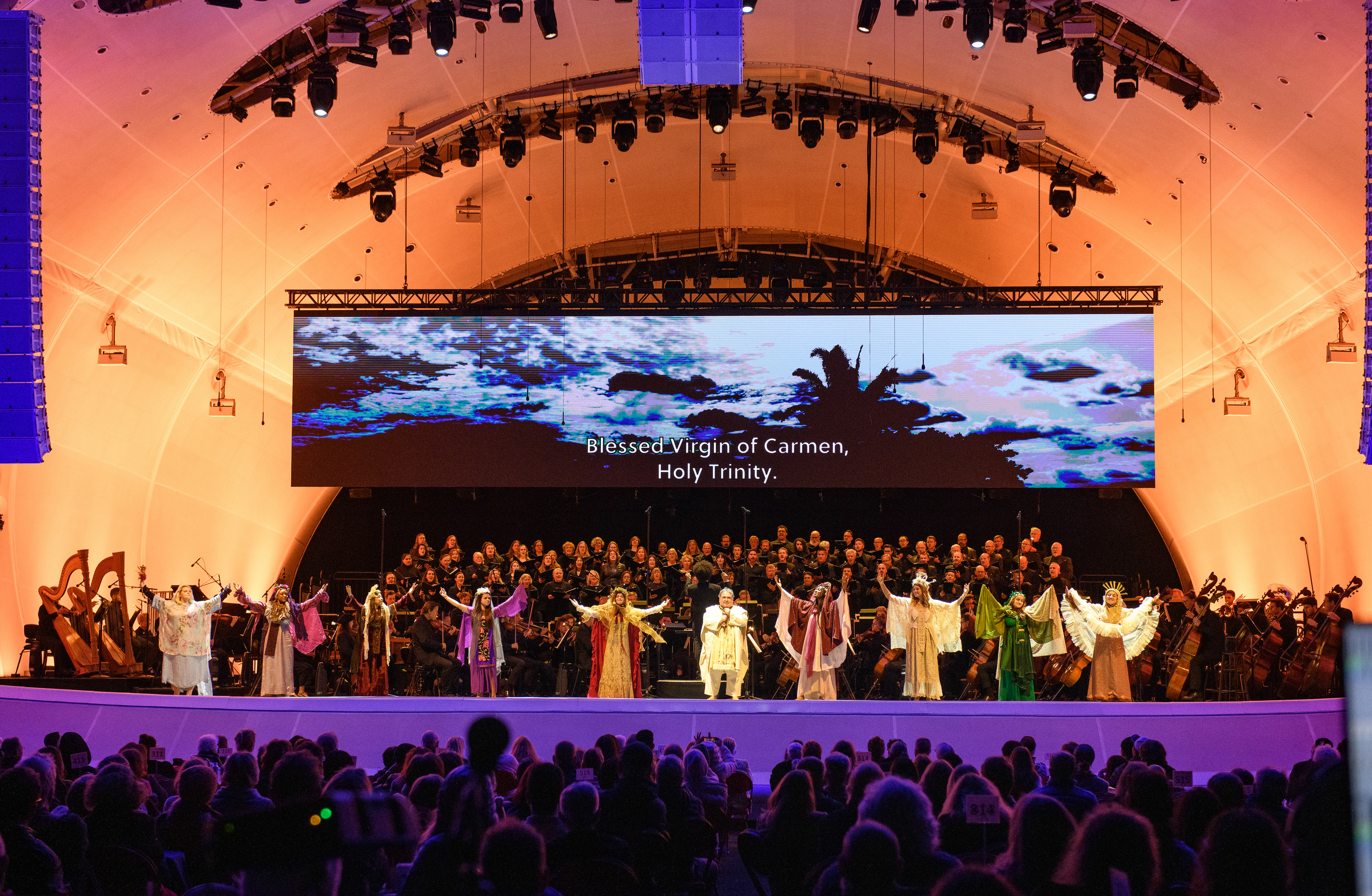The San Diego Symphony and San Diego Master Chorale Bring Antonio Estévez’s Exciting ‘Cantata criolla’ to The Rady Shell
San Diego Symphony Music Director Rafael Payare’s athletic conducting prowess may be his most evident virtue. Even the first-time visitor to a Rady Shell symphony concert can witness his command on the podium and the orchestra’s vibrant response.

Curtain call for Cantata criolla: Aquiles Machado center w/ San Diego Symphony and San Diego Master Chorale (photo: (c.) J.Dixx Photography)
But in the big picture, I contend that Payare’s more important virtue is his stellar programming of new and less familiar symphonic repertory. Because in terms of building the orchestra’s audience, what an orchestra plays is really more important than how polished its interpretive skills may be.
This weekend—the closing weekend of the orchestra’s 2022-2023 season—Payare led an exciting program of almost entirely new and unfamiliar repertory. After opening his concert with Gabriel Fauré’s Suite from Pelléas et Mélisande, Op. 80, a work recognized from its frequently excerpted mellifluous “Sicilienne” movement, the rest of his program charted completely unknown territory. In addition to the major choral offering, Antonio Estévez’s Cantata criolla, Florentino el que canto con el Diablo, Payare partnered this thrilling work with Santa Cruz de Pacarigua by another rarely encountered Venezuelan composer Evencio Castellanos, and added for good measure Paul Dukas’ ballet La Péri: Poème dansé.
Estévez scored his impressive cantata for a large orchestra—two harps and a bulging percussion battery are trustworthy signs of a formidable orchestration—mixed chorus, and two vocal soloists, a tenor taking the part of the everyman Florentino and a baritone playing the Devil. Based on a Spanish language poem by Alberto Arvelo Torrealba, the story relates the victory of the solitary plainsman Florentino who encounters the Devil in the wilderness and comes out alive by winning a singing contest the Devil proposes. To help convey this story, the San Diego Symphony commissioned Alberto Arvelo to create a silent video that projected the scene of this drama on a huge screen suspended above the orchestra and had Solange Arvelo design appropriate costumes for the tenor and baritone who dueled vocally onstage in front of the orchestra and Payare.
Premiered in 1954, Cantata criolla sports a muscular mid-century modernist score, bouncing with sexy Latin American dance rhythms splendidly reinforced with flamboyant percussion, especially drums and marimba. A product of Venezuela’s lauded El sistema and former principal horn player in the Simón Bolívar Orchestra, Payare brought his acute understanding of Venezuelan musical traditions to bear on this complex score, and the orchestra rewarded his zeal with a dazzling performance.
Cast as the Devil, Venezuelan baritone Gustavo Castillo is required to lose the cantata’s song contest to Florentino, but in vocal terms, Castillo’s ringing, soaring baritone easily triumphed over the Venezuelan tenor Aquiles Machado, with no need for a second opinion. Castillo hurled his challenges at Machado with a combination of vocal allure and confident swagger, but tenor’s earnest, slender vocal responses simply did not prove sufficiently persuasive.
Estévez uses the choir as an extension of the orchestra to set the scene and frame the characters’ spiritual encounter, and the San Diego Master Chorale provided a generous, even robust, choral sonority that added depth and color to this vivid tapestry.
Although the half-hour cantata ends too soon—a rare complaint from a jaded critic—Arvelo choreographed a stately religious procession of 9 women in traditional Venezuelan folk costume that made its way through the audience onto the front of The Rady Shell stage as the cantata reached its musical climax, a resonant hymn to the blessed Virgen del Carmen, who miraculously comes to the aid of Florentino at the last moment to triumph over the Devil.
Another composition filled with the songs and dances of a Latin American street fiesta, Castellanos’ Santa Cruz de Pacairigua cleverly set up audience expectations for Estévez’s cantata. Also premiered in 1954, Castellanos’ flashy orchestration tosses off bright solos for trumpet, clarinet and marimba while teasing the listener with his jovial car chase through rapidly changing contrasting meters.
Thanks to Walt Disney, everyone knows Paul Dukas’ clever score The Sorcerer’s Apprentice, but I doubt even serious classical music aficionados could name another work written by this French composer from the early 20th century. Payare and the orchestra made a strong case for his 1912 ballet La Perí, a late Impressionist score that struck me as a succession of rhapsodic waves of suppressed turbulence. The understated fanfares from the horn section gave a special glow to this work, as did the gossamer runs in the flutes’ extreme high register.
In Payare’s generously paced account of the Fauré Suite from Pelléas et Melisande, Principal Flute Rose Lombardo’s graceful solo in the “Sicilienne” was just one of many delectable moments.
This concert was presented by the San Diego Symphony with the San Diego Master Chorale and vocal soloists on May 26 & 27, 2023 at the Rady Shell at Jacobs Park. The May 27 performance was attended for this review.

Ken Herman, a classically trained pianist and organist, has covered music for the San Diego Union, the Los Angeles Times’ San Diego Edition, and for sandiego.com. He has won numerous awards, including first place for Live Performance and Opera Reviews in the 2017, the 2018, and the 2019 Excellence in Journalism Awards competition held by the San Diego Press Club. A Chicago native, he came to San Diego to pursue a graduate degree and stayed.Read more…
